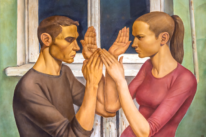
“Many paths lead from the foot of the mountain, but at the peak we all gaze at the single bright moon.” ~Ikkyu
I was the kid who didn’t like to sleep. In nursery school, I would pretend to be asleep at nap time, while the other kids were sleeping. I’ve always thought life was full of exciting things to explore and learn, and I didn’t want to sleep through it.
So, it shouldn’t surprise you that traditional meditation didn’t sit well with me (pun intended). I remember my Buddhist grandmother chanting and meditating twice a day. Yet I never had any interest in mantra meditation until I was in my forties. I thought it was boring, and I didn’t have the patience to sit still.
Meditation helps to lower stress, improve concentration, and increase emotional intelligence. It helps to connect you with your subconscious—also referred to as higher self, intuition, or inner self. There are two concepts to understand before you embark (or disembark) on your journey:
1. There are many ways to meditate.
Just as there isn’t one correct religion for everyone, there isn’t one correct way to meditate. There are hundreds of ways to reach a meditative state.
As a teenager, I experienced an altered state sometimes when I played the piano. Even though piano playing isn’t recognized as a meditation, I knew I was in a meditative state. It felt like my brain was producing more alpha waves, which is what happens with some types of meditation.
My fingers felt nimble. I released my emotions into my playing. Everything seemed to flow. I wasn’t thinking—it was as if my higher self or intuition commanded my fingers.
When doing repetitive chores such as washing the dishes, sometimes I would zone out. It seemed contradictory to zone out while zooming in to focus on the act of washing the dishes. This was my first exposure to mindfulness.
In my twenties, I started learning tai chi and yoga. Iyengar yoga bored me. I enjoyed Ashtanga yoga, also known as Power yoga, but didn’t feel meditative doing it. It felt like an intense stretching class for me.
Likewise, with tai chi, which made me feel like I was doing choreography in slow-mo, but I didn’t feel an altered state. In fact, I studied tai chi for about three years and never felt chi energy. Yet in my first reiki class, I felt the chi. Go figure.
Meanwhile, I was a Polynesian (mostly Tahitian and Hawaiian) dancer. Unlike with tai chi and yoga, I experienced a variety of meditative states when dancing.
High energy dancing to live Tahitian drumming felt like a shamanic meditation of primal energy. Dancing to traditional hula chants felt like a spiritual combination of mantra and moving meditations.
Modern hula songs are usually about love or nature. Dancing about love was an emotion-releasing meditation. Dancing about nature felt like a spiritual nature meditation without being outdoors.
After ten years of Polynesian solo dances, I switched to Latin partner dances such as salsa and Argentine tango.
Improvised, non-choreographed social dancing is enormously fun! It makes me completely focused on the present moment. I get into a meditative state and feel creative and playful.
Dance leaders can’t be as completely in the moment as I can as a follower. They have to think a few microseconds ahead. After all, they’re “driving.”
My favorite partners create with me and give me the space to express myself. They don’t dictate all the moves and try to control me like a puppet.
I imagine that musicians feel a similar flow when they’re jamming spontaneously. In fact, when I dance to live music, the musicians and I often feed off of each other.
They play music that inspires me to dance a certain way. In turn, the energy I give off inspires them. It’s a win-win feedback loop!
When I dance Brazilian samba, even dancing to recorded music can make me feel high. Likewise, African drumming has a shamanic trance energy. I was doing ecstatic dance meditation before I knew there was a name for it.
Going back to mainstream forms of meditation, I’ve taught mindfulness in health education classes. As a communication coach, I’ve taught breathing meditation to help clients relieve public speaking anxiety. I’ve even taught meditation to help develop assertiveness in my ESL (English as a Second Language) students.
In short, there are many ways to get into a meditative state. Don’t let anyone convince you that their method is the only correct way. You may find more than one way that works for you.
2. Don’t judge yourself.
Meditation helps you pay attention to your subconscious and intuition. Yet, paying attention isn’t enough. Your inner self also has to feel comfortable enough to share its thoughts with you.
Your subconscious voice has probably been suppressed for years. As if you were earning the trust of a shy child or a skittish animal, you have to be gentle and kind with yourself.
Don’t judge your thoughts or feelings. Acknowledge and accept them without judgment. They are what they are.
Being critical of yourself counteracts the benefits of meditation. Don’t agonize over how you look when you’re doing yoga. Don’t beat yourself up if you lose track of the number of repetitions you’ve chanted.
Don’t focus on playing the right notes or dancing the right moves. When you relax, you will be more likely to enter a state of meditative flow.
Most importantly, don’t ever feel that you’re doing a meditation wrong. Or feel that a meditative activity isn’t a “real” meditation because it hasn’t been codified and practiced for thousands of years. If grooming your cat or brushing your dog with a flea comb puts both of you into a meditative state, it’s legit.
Listen to your inner self for guidance on what kind of meditation you feel like doing and when you want to do it. Trust that your inner self knows what’s best for you.
About Cynthia Liu
If you’d like to explore a few different forms of meditation, enjoy Cynthia Liu’s short and easy guide: A Meditation Tasting: 12 Easy Practices from Fun to Formal. Cynthia weaves together twenty years of experience in different disciplines to be an alchemist for positive transformation. She is currently a health educator for lifestyle medicine and healthy eating. She’s also an ESL trainer, communication coach, and freelance writer. Visit her at Alchemicita.com.












 Though I run this site, it is not mine. It's ours. It's not about me. It's about us. Your stories and your wisdom are just as meaningful as mine.
Though I run this site, it is not mine. It's ours. It's not about me. It's about us. Your stories and your wisdom are just as meaningful as mine. 